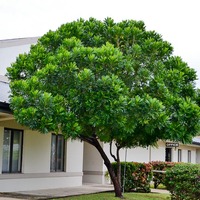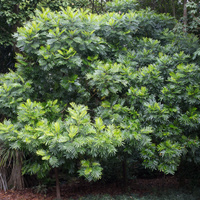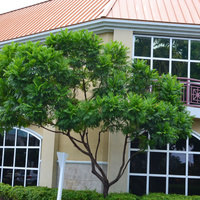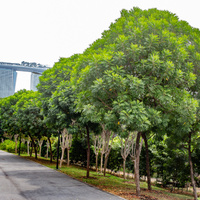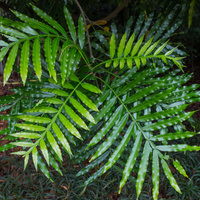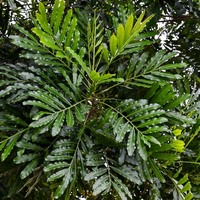Common name: Fern tree
Other common names: Japanese fern tree, Pihimbiya, Thika palm
Description
Native to Sri Lanka, the Western Ghats of southern India and small highland areas of East Africa, the Fern Tree or Thika Palm is best known for its striking foliage, though large specimens also produce a heavy wood.
It is a slow-growing tree with a straight, short trunk and a dense, neatly shaped rounded crown. The bark is smooth and pale brown on young trees, on older trees becoming rough, fissured and flaking. In native forests, it reaches heights of up to 27 m (88 ft), though is more typically 5 to 20 m (16 to 65 ft) tall.
Leaves large, fern-like and showy, up to 40 cm (1.3 ft) long and made up of glossy green elongated oval leaflets arranged in pairs along the length. These are evergreen, remaining on the tree throughout the year.
The flowers are small, white with a pink tint and held in loose clusters that are hardly visible, being hidden by the dense foliage. They bloom from late winter to spring, coinciding with the transition from the dry to the rainy season and are followed by small green oval fruit that become purple-red when ripe.
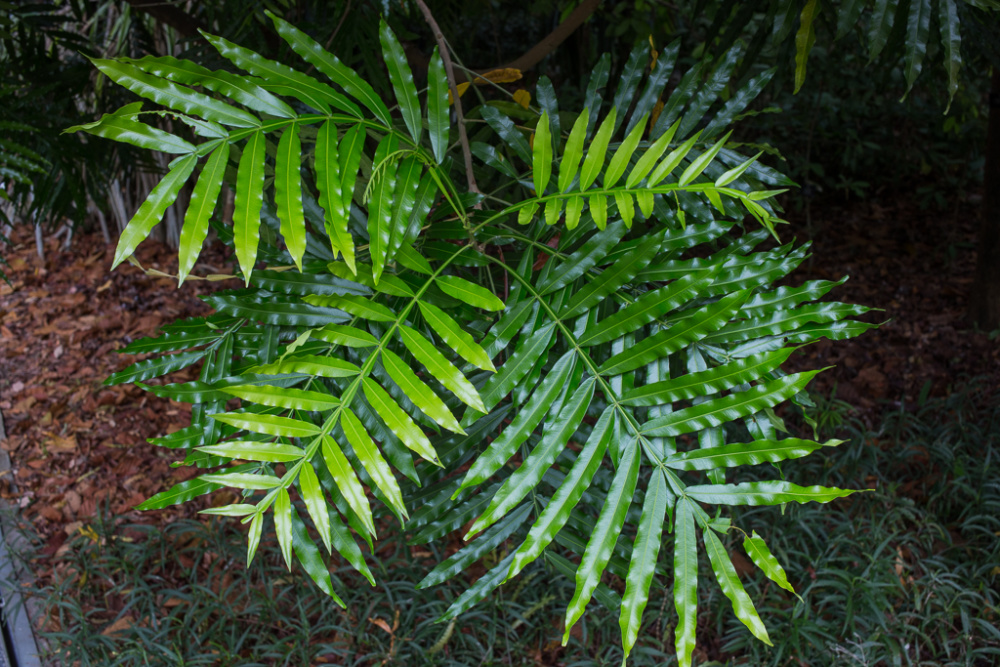
Use
It is a commonly cultivated tree in tropical gardens and landscapes for its lush green, eye-catching foliage, compact size and for the shade it provides. It is a good candidate for a large privacy screen or windbreak, on account of its low-branching habit and dense growth.
Trees on favourable sites produce a hard and heavy wood, averaging above 900 kgs per cubic meter (56 lbs per cubic ft), with moderate to high natural resistance to decay and termites. The heartwood is an attractive reddish-brown and well-formed logs are sawn for durable beams and posts used in heavy construction. The small-diameter roundwood and branchwood is crafted into tool handles and, when properly dried, makes an excellent slow-burning firewood.
Climate
Grows naturally in sub-humid to humid subtropical and tropical climates, generally frost-free areas with annual lows of 13 to 25°C, annual highs of 27 to 35°C, annual rainfall of 800 to 4500 mm and a dry season of 7 months or less. However, it achieves its best development as a timber tree in tropical lowland areas with annual rainfall of 1500 mm or more.
Growing
New plants are usually started from seed which lose their viability quickly and should be sown within a few days of harvesting the fruit. Performs best on free- to slow-draining clay and loam soils of a moderately acid to alkaline nature, generally with a pH of 5.0 to 8.0, and on sites with full to partial sun exposure.
Problem features
Birds are known to eat the fruit and disperse the seed outside of cultivation. It is listed as a weed in at least one reference publication and it is reported to have naturalised on some Hawaiian islands. For some reason, trees in Florida rarely produce viable fruit, hence it is not recorded as invasive there.
Where it grows
References
Books
-
Barwick, M., et al. 2004, Tropical & subtropical trees : a worldwide encyclopaedic guide, Thames and Hudson, London
-
Dharani, N. 2011, Field guide to common trees & shrubs of East Africa, 2nd ed., Struik Nature Publishing, Cape Town
-
Krishen, P. 2006, Trees of Delhi : a field guide, Dorling Kindersley Publishers, Delhi
-
Macmillan, H. F. 1943, Tropical planting and gardening : with special reference to Ceylon, 5th ed, Macmillan Publishing, London
-
Prasanna, P.V. 2012, Trees of Hyderabad: A Pictorial Guide, 1st ed., Botanical Survey of India (BSI), Indian Government Ministry of Environment and Forests, Kolkata
-
Randall, R. P. 2007, The introduced flora of Australia and its weed status, Cooperative Research Centre for Australian Weed Management, Glen Osmond, South Australia
-
Rauch, F. D. & Weissich, P. R. 2000, Plants for tropical landscapes : a gardener's guide, University of Hawaii Press, Honolulu
-
Troup, R.S. & Joshi, H. B. 1975 to 1981, Silviculture of Indian Trees (3 volumes), Government of India Publications, New Delhi
Articles, Journals, Reports and Working Papers
-
National Resources Conservation Service (NRCS) 2012, Pacific Islands Area Vegetative Guide, Technical Note 7., United States Department of Agriculture (USDA), Washington D.C.
